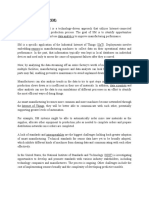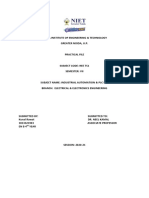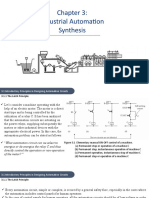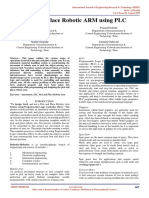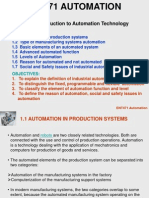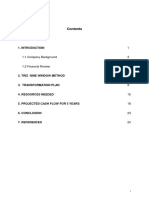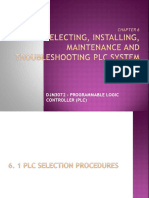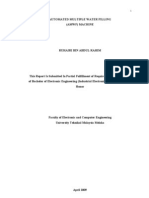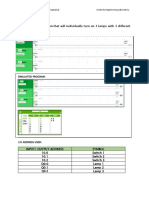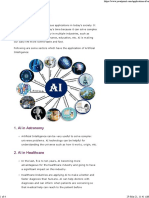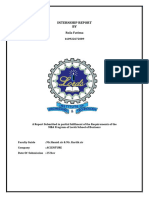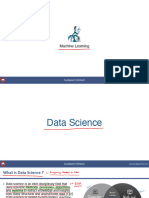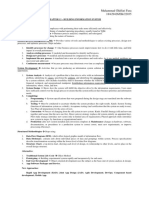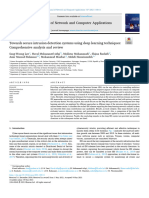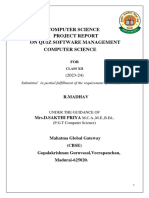1.
Define Automation
Automation refers to a technology which based on the usage of mechanical,
electronic and computer system in handling process and manufacturing process
control. The usage of automation technology started when work done by labour /
worker was started replace by machine. Technology development process continuous
improve until human started introduce the usage of robotic, CAD/CAM, Flexible
manufacturing system and others technology to increase human quality of life and
increase productivity in the industrial.
2. State the main objectives of a modern industry (at least five) and explain the role
of automation in helping achieve these.
To increase labour productivity. Automating a manufacturing operation usually
increases production rate and labour productivity. This means greater output
per hour of labour input.
To reduce labour cost. Ever-increasing tabor cost has been and continues to be
the trend in the world's industrialized societies. Consequently, higher
investment in automation has become economically justifiable to replace
manual operations. Machines are increasingly being substituted for human
lahar to reduce unit product cost.
To migrate the effects of labour shortages. There is a general shortage of
labour in many advanced nations and this has stimulated the development of
automated operations as a substitute tor labour.
To reduce or eliminate routine manual and clerical tasks. An argument can be
put forth that there is social value in automating operations that are routine,
boring, fatiguing, and possibly irksome. Automating such tasks serves a
purpose of improving the general level of working conditions.
To improve worker safety. By automating a given operation and transferring
the worker from active participation in the process to a supervisory role, the
work is made safer. The safety and physical well-being of the worker has
become a national objective with the' enactment of the Occupational Safety
and Health Act (OSHA) in 1970. This has provided an impetus for automation.
�Role of automation in industry
Manufacturing processes, basically, produce finished product from raw/unfinished
material using energy, manpower and equipment and infrastructure.
Since an industry is essentially a systematic economic activity, the fundamental
objective of any industry is to make profit.
Roughly speaking, Profit = (Price/unit Cost/unit) x Production Volume. So profit
can be maximised by producing good quality products, which may sell at higher price,
in larger volumes with less production cost and time. Fig 1 shows the major
parameters that affect the cost/unit of a mass-manufactured industrial product.
Figure 1 The Components of per unit Manufacturing Cost
3. Differentiate between Automation and Mechanization.
Mechanization refers to the replacement of human power with mechanical
power of some form. The use of hand power tools is not an example of
mechanization.
Automation and mechanization are often confused with each other;
Mechanization saves the use of human muscles whereas automation saves the use of
human judgement. Mechanization displaces physical labour, whereas Automation
displaces mental labour as well.
Mechanization affects one or two industries at a time. Automation is the
replacement of human thinking with computers and machines. Automation create jobs
for skilled workers at the cost of unskilled and semi-skilled workers. It affects many
industries at the same time.
4. What are different types of Automation?
Fixed automation is a system in which the sequence of processing (or
assembly) operations is fixed by the equipment configuration. Each of the
operations is the sequence is usually simple, involving perhaps a plain linear
or rotational motion or an uncomplicated combination of the two; for example,
the feeding of a rotating spindle.
In programmable automation, the production equipment is designed with the
capability to change the sequence of operations to accommodate different
product configuration. The operation sequence is controlled by a program,
which is a set of instructions coded so that they can be read and interpreted by
the system.
Flexible automation is an extension of programmable automation. A flexible
automated system is capable of producing a variety of parts (or products) with
virtually no time lost for changeovers from one part style to the next. There is
no lost production time while reprogramming the system and altering the
physical setup (tooling, fixtures, machine settings). Consequently, the system
can produce various combinations and schedules of parts or products instead
of requiring that they be made in batches. What makes flexible automation
possible is that the differences between parts processed by the system are not
significant. It is a case of soft variety.so that the amount of changeover
required between styles is minimal.
5. Can you give an example of an automated system, which contains a control
system as a part of it?
A Mitsubishi RV-M1 Industrial Robot
�6. List some major points why automation is required in industry.
To increase labour productivity. Automating a manufacturing operation usually
increases production rate and labour productivity. This means greater output
per hour of labour input.
To reduce labour cost. Ever-increasing tabor cost has been and continues to be
the trend in the world's industrialized societies. Consequently, higher
investment in automation has become economically justifiable to replace
manual operations. Machines are increasingly being substituted for human
lahar to reduce unit product cost.
To migrate the effects of labour shortages. There is a general shortage of
labour in many advanced nations and this has stimulated the development of
automated operations as a substitute tor labour.
To reduce or eliminate routine manual and clerical tasks. An argument can be
put forth that there is social value in automating operations that are routine,
boring, fatiguing, and possibly irksome. Automating such tasks serves a
purpose of improving the general level of working conditions.
To improve worker safety. By automating a given operation and transferring
the worker from active participation in the process to a supervisory role, the
work is made safer. The safety and physical well-being of the worker has
become a national objective with the' enactment of the Occupational Safety
and Health Act (OSHA) in 1970. This has provided an impetus for automation.
7. What are the advantages and disadvantages of automation?
advantages
To increase labour productivity.
To reduce labour cost.
To migrate the effects of labour
shortages.
To reduce or eliminate routine
manual and clerical tasks.
To improve worker safety.
To improve product quality.
To reduce manufacturing lead
lime.
To accomplish processes that
cannot be done manually.
To avoid the high cost of not
automating.
disadvantages
Higher Start-up cost and the cost of
operation.
Higher Cost of Maintenance.
Obsolescence/Depreciation Cost.
Unemployment.
Not economically justifiable for
small scale production.
�8. (a) Discuss the basic elements of an automated system. (b) Describe with neat
sketch close loop and open loop control system.
1. Power source: An automated system is used to operate some process and
power is required to drive the process as well as controls. There are many
sources of power available, but the most commonly used power is electricity.
The actions performed by automated systems are generally of two types:
(a) Processing
(b) Transfer and positioning
In the first case, energy is applied to accomplish some processing
operation on some entity. The process may involve shaping, moulding or
Loading and unloading. All these actions need power to transfer the entity
from one state or condition into more valuable state or condition.
The second type of actions-transfer and positioning. In these cases, the
product must generally be moved from one location to another during the
series of processing steps.
2. Program of instructions: The actions performed by an automated process are
defined by a set of instructions known as process. The programmed
instructions determine the set of actions that is to be done automatically by the
system. The program specifies what automated system should do and how its
various components must function in order to accomplish the desired results.
3. Control system: The control element of the automated system executes the
program of instructions.
The controls in an automated system can be:
a. Closed loop
b. Open loop.
Closed loop control system: It is also known as a feedback control system. In this
system the output variable is compared with an input parameter and any difference
between the two is used to drive the output into agreement with input.
1. Input parameter: as set point, represents the desired value of output.
2. Output variables: actual value of parameter.
�3. Sensors: A sensor is used to measure the output variable and close the loop
4. between input and output: It performs feedback function.
5. Controller: The controller compares the output with the input and makes the
required adjustment in the process to reduce the difference between them.
6. Actuator: The adjustment being done with one or more actuator which are the
hardware devices that physically carry out the control actions such. Electric motor,
cylinder etc.
Open loop control system: It is without the feedback loop. In this case the controls
operates without measuring the output variables, so no comparison is made between
the actual value of the output and desired input parameters There is always risk that
the actuator will not have intended effect on the process.
9. How do you classify assembly lines? Explain.
Assembly lines are special flow-line production systems which are of great
importance in the industrial production of high quantity standardized commodities.
Recently, assembly lines even gained importance in low volume production of
customized products (mass-customization). Due to high capital requirements when
installing or redesigning a line, its configuration planning is of great relevance for
practitioners. Accordingly, this attracted attention of many researchers, who tried to
support real-world configuration planning by suited optimization models (assembly
line balancing problems). In spite of the enormous academic effort in assembly line
balancing, there remains a considerable gap between requirements of real
configuration problems and the status of research. To ease communication between
researchers and practitioners, we provide a classification scheme of assembly line
balancing. This is a valuable step in identifying remaining research challenges which
might contribute to closing the gap.
10. Why does an automated system achieve superior performance compared to a
manual one? Can you give an example where this happens?
Because such systems can have more precision, more energy and more speed
of operation than possible manually. Moreover using computing techniques, much
more sophisticated and efficient operational solutions can be derived and applied in
real-time. This is the rule. Only few exceptions exist. How many of the millions of
industrial products could be made manually?









